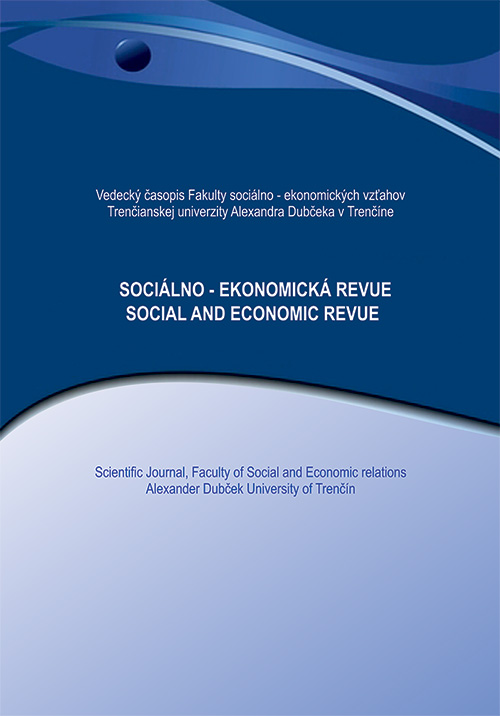DISPARITIES AMONG REGIONS OF THE VISEGRAD GROUP COUNTRIES
Regional disparities among countries and its measurement is an important topic in the frame of enlarged European Union. We can identify several approaches and methods of measurement and evaluation of disparities between states and regions at Visegrad group countries level. The methods differ in structure of using indicator of disparities and ways of their processing. The aim of the paper is to apply specific model of composite weighted aggregate index of regional disparities in the case of Visegrad group countries. In the theoretical part are briefly described various procedure of construction of Composite Indicator, their advantages and disadvantages. The construction of this aggregated indicator is based on the application of more complex and multidimensional statistical methods.
Vydanie: 2019/3 Strany: 54-63 Klasifikácia JEL: C34, C52, R23
DOI:
Kľúčové slová: Regional disparities, Composite Indicator, multivariate statistical methods
Sekcia:
Kontakty:
Dana, Jašková, RNDr., PhD.
Department of Economy and Economics,
Faculty of Social and Economic Relations,
Alexander Dubček University of Trenčín
Študentská 3, 911 50 Trenčín, Slovakia,
e-mail: dana.jaskova@tnuni.sk
Literatúra:
Bandura R. (2008). A Survey of Composite Indices Measuring Country Performance: 2008 Update. United Nations Development Programme – Office of Development Studies. [acc.: 2019-08-14]. Available at: https://www.undp.org/content/dam/undp/library/corporate/Development%20Studies/indices_2008_bandura.pdf
Booysen, F. (2002). An Overview and Evaluation of Composite Indices of Development. Social Indicators Research. 59(2), 115-151.
European Commission. (2015). Is my region covered? [acc.: 2019-15-11]. Retrieved from: http://ec.europa.eu/regional_policy/en/policy/how/is-my-region-covered
Cuaresma, J., Oberhofer, H., Vincelett, G. (2014). Institutional barriers and job creation in CEE. IZA Journal of European Labour Studies, 3(3), 1-29.
Cherchye, L., Moesen, W.,Rogge, N., van Puyenbroeck, T. (2007). An introduction to ´benefit of the doubt´ composite indicators. Social Indicators Research, 82, 111-145.
Koisova, E., Grmanova, E., Skrovankova, K., Kostrova, J. (2019). Competitiveness of Regions in the Visegrad Group Countries. Inzinerine Ekonomika-Engineering Economics, 30(2), 203-210.
Habánik, J. et al. (2014). Regionálna ekonomika a rozvoj. Trenčín: FSEV TnUAD.
Hrach, K., Mihola, J. (2006). metodické přístupy ke konstrukci souhrných ukazatelú. Časopis Statistika, Praha: ČSÚ, 5, 398-418.
Kutscherauer, A. et al. (2010). Regionální disparity v územním rozvoji České republiky – jejich vznik, identifikace a eliminace. [acc.: 2019-08-14]. Available at: http://alkut.cz/edice_cd/cd10_regdis_ monografie/pdf/region_disparity_monografie.pdf
Melecký, L. (2016). Application of composite weighted indices approach in regional disparities measurement. 19th International Colloquium on Regional Sciences. Brno: Masarykova univerzita, pp. 1–5.
Michálek, A. (2013). Vybrané metódy merania regionálnych disparít. [acc. 2019-08-10]. Retrieved from: https://www.sav.sk/journals/uploads/12121204Michalek.pdf
Minařík, K., Borůvková, J., Vystrčil, M. (2013). Analýzy v regionálním rozvoji. Professional Publishing, Příbram.
Micklewright, J., Stewart, K. (2002). Poverty and social exclusion in Europe: European comparisons and the impact of enlargement. New Economy, 104-109.
Nardo, M., Saisana, M., Saltelli A., Tarantola S., Hoffman A., Giovannini E. (2005). Handbook on constructing composite indicators: methodology and user guide, OECD Statistics Working Paper, Paris.
OECD (2008). Handbook on Constructing Composite Indicators. Methodology and User Guide. Paris: Organization for Economic Co-operation and development.
Rogge, N. (2012). Undesirable specialization in the construction of composite policy indicators: The environmental performance index. Ecological Indicators, 23, 143-154.
Saisana M., Tarantola, S. (2002). State-of-the-art report on current methodologies and practices for composite indicator development, EUR 20408 EN, European Commission-JRC: Italy.
Saisana M., Tarantola, S., Saltelli, A. (2005). Uncertainty and sensitivity techniques as tools for the analysis and validation of composite indicators. Journal of the Royal Statistical Society. A 168(2), 307-323.
Sloboda, D. (2006). Slovensko a regionálne rozdiely. [acc.: 2019-10-11]. Retrieved from: http://www3.ekf.tuke.sk/re/Disparity%2520a%2520perifernost/Regionalne%2520disparity/Slovens...
Smerkowski, M. (2014). Regional disparities and development dynamics of CEE regions in the period of prosperity and austerity. GRINCOH Working Paper series, Series 6, Spaces, territories and Regions. Paper No 6.02.01. [acc.: 2019-15-11]. Retrieved from: www.grincoh.eu › working-papers.
Štatistický úrad SR. [on-line] [acc.: 2019-11-11]. Retrieved from: https://slovak.statistics.sk
Verschelde, M., Rogge, N (2012). An environment-adjusted evaluation of citizen satisfaction with local police effectiveness: Evidence from a conditional data envelopment analysis approach. European Journal of Oprational Research, 223(1), 214-225.
Zdražil, P., Kraftová, I. (2012). Do the V4 regions Convergence? 15th International Colloquium on regional Sciences. Brno: Masarykova univerzita. 48-58.


